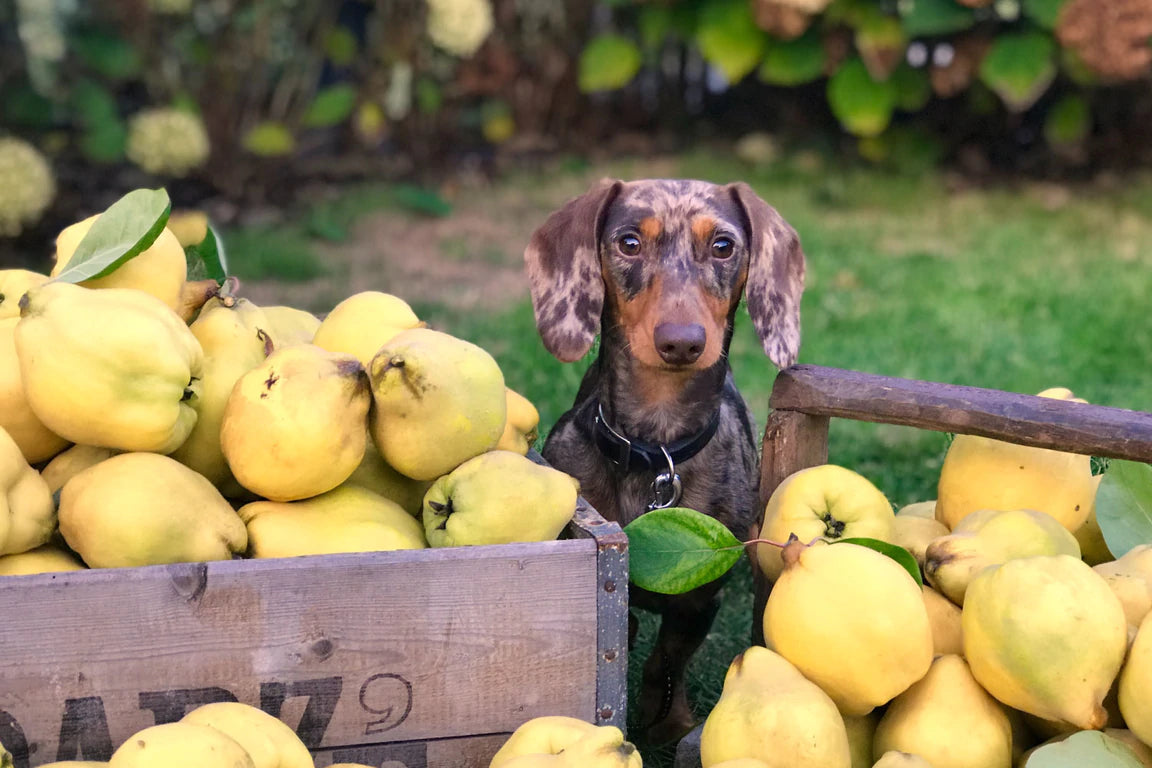At Health Extension, our number one mission is to provide the highest-quality food for your pet. That means we maintain human-grade standards when it comes to our ingredients, using only all-natural, traceable to the source, non-GMO components in our organic pet foods and products. Why? Because your pet deserves the best food for a healthy life. But also – the truth is – the market is saturated with sub-standard pet food products.
This sentiment is true in all categories: Great products cannot be made with profit as the ultimate goal. In almost any industry, you will see quality being traded off for larger margins. In the textile industry, for instance, that means trading out organic cotton for inexpensive, synthetic fibers. In the food industry, it usually means supplementing whole, natural ingredients with fillers, by-products and synthetic preservatives. The dog food category is especially susceptible to these tactics as regulations are low and consumers are often under-educated on the ingredients found on the label.
Thanks to a greater ability to access information, consumers today are able to make better decisions in regard to what they buy. And the food you feed your pet should be no different. That’s why we put together this detailed guide itemizing common ingredients to avoid in dog food.
How to spot sub-standard dog food
The quickest way to weed out any sub-standard pet product is to read the label. Despite compelling marketing campaigns and packaging, manufacturers cannot actually hide what’s on the inside of their products – for the most part. Your greatest defense against harmful ingredients is to simply read the label. But decoding that can feel like it requires a PhD. So, we’ve tried to simplify it for you below.
“Meat” or Animal By-Product
Animal by-products are the leftovers from the meat industry. Animal by-products can include expired grocery meat, zoo animals, diseased and euthanized animals and even roadkill. The components of meat by-products can be comprised of numerous parts of the animal – not just muscle tissue.
These ingredients often lack nutritional content because of the way in which they are processed to try to ensure they’re “safe” for consumption. With no real ability to determine their value, it can be difficult to track your dog’s overall nutrient intake. In this case again, it’s best to choose whole-meat products rather than those made with meat by-products.
In addition to that, whenever you encounter an ambiguous ingredient on a food label, you can surmise that the ingredient itself is a mixture of numerous sources. In the case of “meat”, it’s often the by-product of animal meat and other components. Not only are you unaware of the type of meat that it is, but due to the way in which the meat itself is processed, there is no way to determine its nutritional content – or lack thereof. Excessive heating is meant to remove pathogens, but also strips nutritional content, leaving a low-grade protein product behind. Always choose products with whole-meat ingredients listed, such as chicken, lamb or salmon.
Plant Proteins, AKA “Ingredient Splitting”
Plant proteins can be used to boost protein levels and provide other beneficial nutrients, however, the over use of plant proteins could be a sign of cutting corners in the production process to increase margins. This is where you will see manufacturer’s “split” ingredients. The label will still read that the first ingredient is meat or meat meal creating the illusion that the primary protein source is in fact animal-based. Immediately following you will see plant proteins, animal fats, etc. – and then plant-based protein or flours. Examples often include, but are not limited to, pea protein, pea flour, potato protein or potato flour.
Artificial Preservatives
Preservatives are important in all foods to help them maintain their shelf-life. But synthetic preservatives have been linked to health problems such as kidney failure, liver issues, immune deficiencies and even cancer. Some known carcinogenic preservatives that have been used in dog food include:
- Ethoxyquin
- Butylated Hydroxyanisole (BHA)
- Butylated Hydroxytoluene (BHT)
- Sodium Tripolyphosphate
In addition to that, Nitrites or Nitrates (Sodium Nitrite) are a common ingredient used to preserve meats in both pet and human foods. In high doses, it can cause a blood disorder known as Methaemoglobin, which has been linked to cancer.
While preservatives are often necessary, you can choose foods that use natural preservatives instead. These include vitamin C (ascorbic acid), vitamin E (mixed tocopherols), or rosemary.
Dyes
Dyes are a sales tool – not a nutritional component. They offer no sustenance, rather, they are used to make foods look appealing. If health is your optimal goal, avoid purchasing any foods with added dyes. In addition, dyes are thought to contribute to allergies, hyperactivity and even tumor growth. Some of the most common food dyes include:
- Red 40
- Blue 2
- Yellow 5
- Titanium Dioxide (Used as a bleaching agent)
Fillers
This entire category is often touted in marketing campaigns to separate “good” products from “great” ones. Fillers are considered ingredients used to boost overall product content, increasing total yield for a fraction of the cost. The problem with filler ingredients is they often contain a less desirable nutrient content, which are less bio-available for your dog. That means that their gastrointestinal system is unable to render a high amount of the nutrients out of those ingredients and into their system during digestion. Common fillers also tend to increase overall carbohydrate content, which can lead to obesity. Remember: dogs are carnivores. Their diet should always include foods with meat as the primary ingredient. Some common filler ingredients include:
- Rice Bran
- Any Corn ingredient
- Soybean Hulls
- Wheat Mill Run
- Modified Cornstarch
- Oat Hulls
Soy
Soy is an extremely common “filler” ingredient used in both pet and human products. While it does have nutritional benefits, it’s a low-quality nutrient compared to other options. For the most part, you can assume that products made with a high volume of soy are not optimally developed for your dog’s nutritional benefit. Here are some other reasons why soy is a low-grade ingredient:
- Not bio-available
- Hard to digest
- Causes bloating
- Common allergen
- Contains phytoestrogens to mimic estrogen, throwing off their hormone levels
- Contains Goitrogens which may inhibit proper thyroid functioning
Gluten
Limiting gluten intake is a smart choice for all pets as high quantities can result in the development of allergies and digestive issues. A lot of pets fall victim to this due to high gluten content found in products with a lot of grain fillers. Chronic ear infections can be a sign that your dog is eating too much gluten in their diet. Choosing formulas made with brown rice or oatmeal instead can help alleviate your dog’s gluten intake.
Flavor
Unless the label lists a flavoring as natural, assume it isn’t. Great dog food should not contain synthetic flavoring agents of any kind. “Animal digest” is another way to add flavoring as well. It’s a concentrated liquid broth made up of processed meat which is sprayed onto pet food to give it additional flavor. Many foods contain this so that they can print things like “chicken flavored” without actually containing any meaningful chicken in the product itself. But again, any well-made dog food doesn’t need added flavor!
Monosodium Gutamate (MSG)
MSG is among the sneakiest of ingredients that pop up on food labels. It’s primarily used to add flavoring to products. MSG is thought to contribute to obesity in animals and can affect a dog’s insulin levels. It is also a suspected neurotoxin, with the ability to cause chest pain, headaches and mood changes. And while the FDA does not require that MSG be listed on the label, here are many of the ingredients that fall under this category:
- Hydrolyzed Protein
- Protein Isolate
- Texturized Protein
- Autolyzed Yeast
- Hydrolyzed Yeast
- Yeast Extracts
- Soy Extracts or Concentrate
- Sodium Caseinate
- Calcium Caseinate
- Monopotassium Glutamate
- Glutamate or Glutanic Acid
- Disodium Inosinate or Guaylate
Corn Syrup
Corn syrup is a refined sugar used to sweeten foods. However, it can cause spikes in blood sugar and contributes to weight gain, obesity, and diabetes. It has no value in dog food other than to make it more appetizing. This is one ingredient to avoid altogether if you can.
Sugar Alcohols
Sugar alcohols are also known as sugar substitutes. They are commonly used in diet foods to add sweetness without the calories. But they have also come under scrutiny for having negative health effects on people, and of course, on pets as well. In fact, they can be deadly for pets if consumed in high levels. These ingredients affect blood sugar primarily and can cause significant spikes, and drops, triggering both hyperglycemia or hypoglycemia. Dogs can also experience seizures and liver failure as a result. Some sugar alcohols include:
- Sorbitol
- Malitol
- Xylitol
Salt
Salt is a necessary mineral for a well-rounded diet, but high levels of salt – or sodium – can contribute to high blood pressure and other conditions including stomach cancer, stroke, and cardiovascular disease. You should be mindful of your dog’s daily sodium intake and try to keep it to 2500mg or less per day, being conscientious of the salt content in other forms of food, such as treats and bones.
Rendered Fat
Your dog needs fat in their diet. It’s a critical component to their overall health. But the quality of that fat is important. Rendered fats, listed as “animal fat” or “poultry fat,” often includes the fat of animal by-products. During the sterilization process, these fats are gathered and repurposed into dog foods. The fat of low-quality meat tends to include a higher toxicity level than higher-quality meat fats. Always choose dog foods that have specified animal fats.
Vegetable oil is another fat that is used in both human and pet foods. These represent omega 6 fatty acids and are known to contribute to inflammation, arthritis, and hip and joint issues, among other problems. You should also avoid tallow and lard for these same reasons.
The best source of fat will come from omega 3 fatty acids, which can be found in certain fish oils and nuts.
Propylene Glycol
Another way to make foods look more appealing is to increase their moisture content. Propylene Glycol does just that – but high amounts are believed to be toxic for your dog. It’s already banned from cat food as it has been shown to cause Heinz Body Anemia when eaten in large amounts.
Cellulose
Cellulose is a plant-based complex carbohydrate used in food products as a thickening agent. It’s seen in a variety of human consumable products, especially in dairy goods as a cheap binding or emulsifying alternative. However, cellulose is not digestible for your dog and provides no nutritional benefit. For the health of your pet, it’s best to avoid foods with cellulose as a listed ingredient altogether.
Sodium Hexametaphosphate
Sodium Hexametaphosphate is used in many pet products to reduce tartar. And while it’s a great way to promote healthy teeth, this ingredient can be harmful in high doses. It’s been proven to be a skin and inhalation irritant in humans, and likely has similar indications for your dog.
Carrageenan
Extracted from red seaweed as a thickener, a version of this ingredient has been shown to create gastrointestinal inflammation and potentially cancer.
How to Pick High-Quality Pet Food
All food labels list ingredients in the order that represents the highest concentrations first. Therefore, purchasing foods that list quality meat sources among the first ingredients is a great way to ensure your pet is getting the protein content they crave.
Be mindful of the level of carbohydrates in your dog’s food. Limiting carbohydrates in your pet’s diet will help improve their overall nutritional intake and digestive performance.
Also, consider foods with nutrient-rich plant ingredients like carrots, kelp, blueberries and pumpkin, for example. The more whole-food ingredients you see listed on the label, the more likely that these products are made with your dog’s health at heart.
You can also advocate for your pet by reviewing ongoing pet food recalls. Don’t assume that well-known, name-brand pet foods are not susceptible to food recalls. At Health Extension, we’re proud to say that our products have never been part of a pet food recall, and we believe that our attention to high-quality, natural ingredients is the reason for that. When your mission is overall health, it’s easy to create the best products on the market. Shop our wide-range of pet foods and products here: https://www.myhealthextension.com



